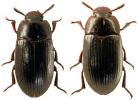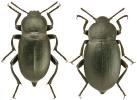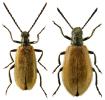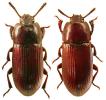Images:
A varied family, with 47 species in Britain. 1.5-25mm long, many are synanthropic, particularly in cellars and stables but also in stored products. Tenebrio molitor (L.) is the familiar mealworm, sold as food for birds or reptiles while Tribolium spp. are pests of flour and grains in both industrial and domestic situations. Subfamily Diaperinae are found in fungi and decaying wood or other vegetable matter. This subfamily includes Diaperis boleti (L.), an attractive orange and black species found in bracket fungi which can be mistaken for a Chrysomelid.
Two species (Myrmechixenus subterraneus Chevrolat and M.vaporariorum Guerin-Meneville) are associated with ants, but both are rare. Nalassus laevioctostriatus (Goeze) is widespread and common on tree bark after dark. Several species are largely coastal in distribution, and should be looked for at the bases of plants in dune systems. Lagria hirta (L.) is an elongate-oval species which can be abundant in mid-summer. It has mid-brown, hairy elytra and jet-black head, thorax and appendages and can be found on low vegetation or at light.



























